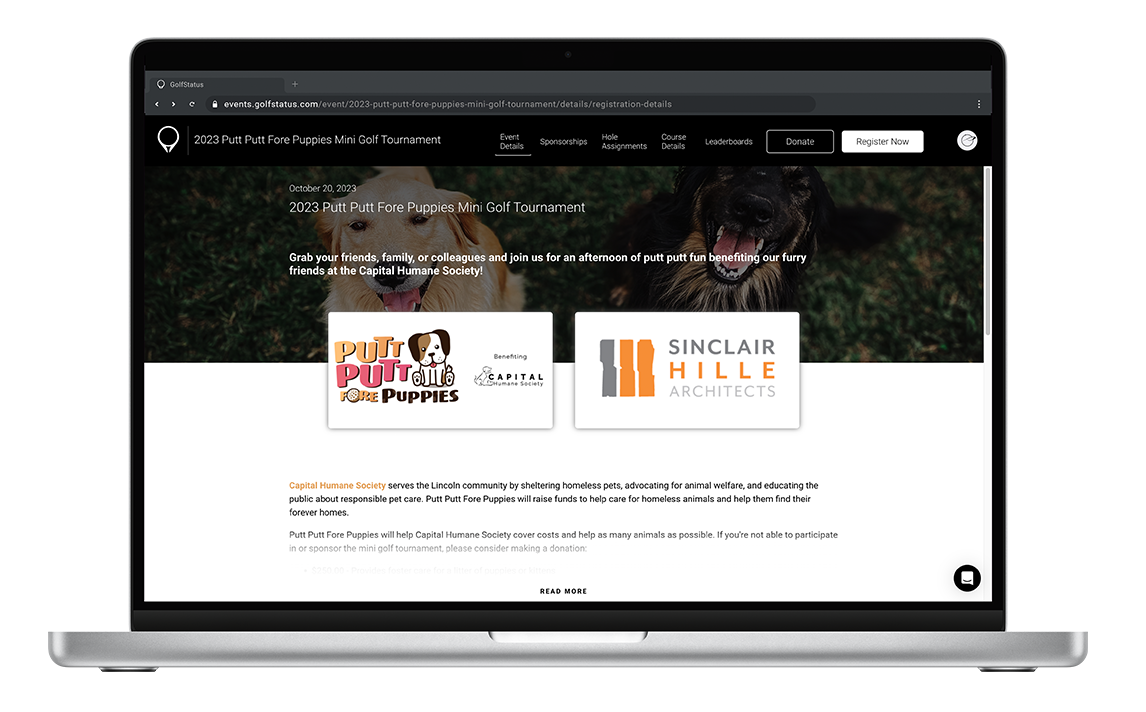Your event website functions as the home base for your golf tournament, where folks can find out more about the event, learn about your organization, and register or purchase a sponsorship. Your event website also has a secret weapon—the donate button.
It’s a more-powerful-than-you-think tool that you can use to do far more than simply accept donations. You can collect payments for a number of tournament add-ons via the donation button. This keeps all payments and event revenue in one spot, making it easy to track income, simplify accounting, and run robust event reports.
How Does It Work?
Simply send folks right to the donate page on your event website. If you’re sending information to participants electronically (via email or push notifications), include a clickable direct link. If you’re using any printed materials (like flyers or signage), add a QR code golfers can scan on their phone that takes them right to the donation page. Use the page to:
1. Collect Donations
Build strategic donation asks into your tournament day using emails, push notifications, social media, and in-person appeals. Challenge golfers to donate their final score or the score of the winning team or set up a donation station to collect gifts. You’ll onboard new donors you can further steward after the tournament!
2. Show Progress Toward Your Fundraising Goal
Donors love seeing the impact their gift is making. A quick and easy way to do that is having a bar that tracks progress toward your donation goal. Make sure donors can see it during checkout so they can instantly see how their gift has helped move the needle.
Event websites powered by GolfStatus make it easy for you to track your event day fundraising goal.
3. Collect Auction Payments
Particularly if you’re not using a standalone online auction platform or one that doesn’t process payments, you need an easy way for winning bidders to pay for their items. Simply direct folks to the donate page and make a note of the item or items they won for reporting purposes.
4. Pay for On-Course Games & Contests
On-course games and contests are a great way to raise additional dollars the day of the tournament. Golfers can pay to have a pro take the tee shot for them, enter a putting contest, or participate in any other fun on-course competition right from the event website. Alternatively, you could set up specific packages for games and contests and direct folks to the registration page if you’re interested in separating those out for accounting purposes.
Golfers participate in a “blind putt hole” on-course game at a golf fundraiser.
5. Track Matching Donations
If you have a donor willing to match donations made the day of the tournament, sending everything through the event site makes it super simple to track the match. Highlight how donors’ gifts will be matched (if it’s a 1:1 match or other ratio plus the maximum match amount) and recognize the generous donor (if they want to be publicly recognized, that is).
6. Sell Mulligans or Raffle Tickets
Allow golfers to buy these when they check in on tournament day, or consider setting up a station or stations on the golf course where folks can buy mulligans or raffle tickets. Setting up a station before a particularly difficult hole might boost your mulligan sales! You also have the option to build out mulligan or raffle tickets packages, like mentioned under on-course games and contests.
Golfers can make a payment or donation right from their mobile phone before, during, or after the golf tournament.
Final Thoughts
The last thing you want to worry about on tournament day is hanging on to a wad of cash, manually entering credit card numbers, or reconciling Venmo payments. Instead, direct golfers to your event website and keep everything in one, unified place to simplify your post-tournament accounting.
GolfStatus’ tournament management software makes it simple. It starts with a professional event website, is powered by an industry-leading support team and an intuitive backend that’s easy for avid golfers and non-golfers alike, and ends with robust reporting and printouts. Best of all, nonprofits (and third parties holding golf tournaments to benefit a nonprofit or charity) can qualify to use GolfStatus’ platform at no upfront cost through the Golf for Good program. It’s not too good to be true! Click the button to find out more and get qualified.







































